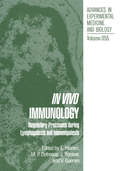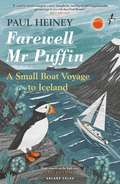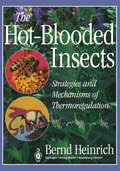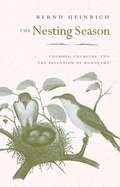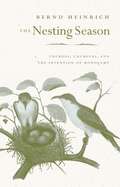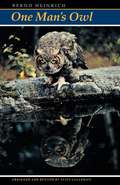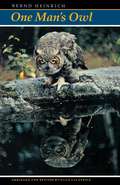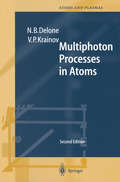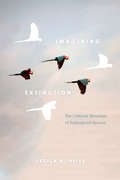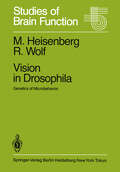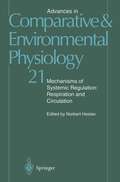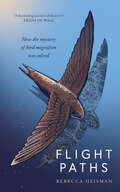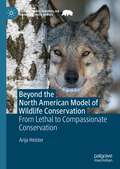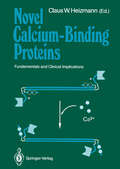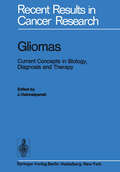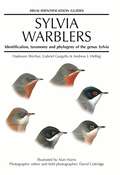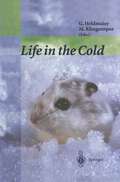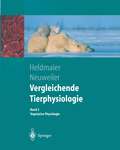- Table View
- List View
In Vivo Immunology: Regulatory Processes during Lymphopoiesis and Immunopoiesis (Advances in Experimental Medicine and Biology #355)
by E. Heinen M. P. Defresne J. Boniver V. GeenenThe 11th International Conference on Lymphoid Tissues and Immune Reactions was held in Spa-Liege (Belgium), from 4 to 8 July 1993. The regular devotees refer to these conferences as the "Germinal Centre Conferences or GCC". In the 1960s, the germinal centres were the subject of such considerable study and speculation that a group of dynamic people decided to devote an international conference centered on that topic. This led to the fIrst GCC organized in Bern in 1966. Following the success of this initial meeting, further sessions have been organized at regular intervals and, over the years, the scope of the GCC has been broadened. Nowadays, the GCC conferences are dedicated to in vivo immunology and deal mainly with cellular, functional and molecular aspects of the lymphoid system. The credo of these conferences is "in vivo veritas," implying that the sole investigation of components (like molecules or cell populations) only gives a partial truth. Ultimately, the components have to be explored in their global context in order to see how they interact with other parts and how they are integrated as a whole to ensure the homeostasis of the immune system. In 1966, the GCC lasted 3 days and included 57 contributions "which were discussed at length. " The present conference lasted 4 days and accommodated 2 honorary lectures, 80 free papers and 209 poster presentations. Out of those presentations, a selection was performed by the Chairpersons to compose the present volume.
Farewell Mr Puffin: A small boat voyage to Iceland
by Paul Heiney'It would be hard to imagine a more thoughtful, intelligent and companionable person to go to sea with than Paul Heiney.' Bill Bryson'High comedy on the high seas. Informative and warm and freezing. It's quite a combination.' Griff Rhys JonesThe puffin is the joker amongst the seabirds of the north Atlantic, but what is happening to this much-loved bird is far from a laughing matter.This is the conclusion of writer and broadcaster, Paul Heiney, who set sail from the east coast of England bound for Iceland, propelled by a desire to breathe the cool, clear air of the high latitudes, and to follow in the wake of generations of sailors who have made this often treacherous journey since the 13th century. In almost every harbour he tripped over maritime history and anecdote, and came face to face with his own past as he sailed north along his childhood coastline of east Yorkshire towards the Arctic Circle.But there was one major thing missing from this voyage - the sight of puffins. They are remarkable birds, uplifting as a ray of sunshine after a storm. To see them and share their waters was also part of Heiney's ambition. Imagine then his disappointment when, first, no puffins appeared off the Farne Islands, then none to be seen on puffin hotspots like Orkney. When he failed to see puffins on Iceland, it was the last straw, and he started to become seriously concerned. Heiney senses that a new chapter is about to be written, and it is one in which we may have to say farewell to the puffin forever.This book is rich in travel and sailing narrative, natural and social history, and with a strong undercurrent of good humour. It provides not only an insight into the private life of the puffin, but an honest portrait of human life on the ocean waves, as well as a reflection on what we might lose if the puffin disappears from our icy northern waters.
Farewell Mr Puffin: A small boat voyage to Iceland
by Paul Heiney'It would be hard to imagine a more thoughtful, intelligent and companionable person to go to sea with than Paul Heiney.' Bill Bryson'High comedy on the high seas. Informative and warm and freezing. It's quite a combination.' Griff Rhys JonesThe puffin is the joker amongst the seabirds of the north Atlantic, but what is happening to this much-loved bird is far from a laughing matter.This is the conclusion of writer and broadcaster, Paul Heiney, who set sail from the east coast of England bound for Iceland, propelled by a desire to breathe the cool, clear air of the high latitudes, and to follow in the wake of generations of sailors who have made this often treacherous journey since the 13th century. In almost every harbour he tripped over maritime history and anecdote, and came face to face with his own past as he sailed north along his childhood coastline of east Yorkshire towards the Arctic Circle.But there was one major thing missing from this voyage - the sight of puffins. They are remarkable birds, uplifting as a ray of sunshine after a storm. To see them and share their waters was also part of Heiney's ambition. Imagine then his disappointment when, first, no puffins appeared off the Farne Islands, then none to be seen on puffin hotspots like Orkney. When he failed to see puffins on Iceland, it was the last straw, and he started to become seriously concerned. Heiney senses that a new chapter is about to be written, and it is one in which we may have to say farewell to the puffin forever.This book is rich in travel and sailing narrative, natural and social history, and with a strong undercurrent of good humour. It provides not only an insight into the private life of the puffin, but an honest portrait of human life on the ocean waves, as well as a reflection on what we might lose if the puffin disappears from our icy northern waters.
The Hot-Blooded Insects: Strategies and Mechanisms of Thermoregulation
by Bernd Heinrich"From one man's persistent and elegant probing of the temperature biology of bees, we have been led to a deeper understanding of the whole biology of many insect taxa, and of their interactions with ecological and environmental stresses: all who work at the interfaces of physiology, ecology and behaviour have cause to be grateful, and all should certainly read this book." (Trends in Ecology & Evolution) "An outstanding source of information, and can be read with profit and satisfaction by the professional biologist and interested amateur alike." (Nature)
The Nesting Season: Cuckoos, Cuckolds, And The Invention Of Monogamy
by Bernd HeinrichOne of the world’s great naturalists and nature writers, Bernd Heinrich shows us how the sensual beauty of birds can open our eyes to a hidden evolutionary process.
The Nesting Season: Cuckoos, Cuckolds, And The Invention Of Monogamy
by Bernd HeinrichOne of the world’s great naturalists and nature writers, Bernd Heinrich shows us how the sensual beauty of birds can open our eyes to a hidden evolutionary process.
One Man's Owl: (Abridged Edition)
by Bernd HeinrichThis engaging chronicle of how the author and the great horned owl "Bubo" came to know one another over three summers spent in the Maine woods--and of how Bubo eventually grew into an independent hunter--is now available in an edition that has been abridged and revised so as to be more accessible to the general reader.
One Man's Owl: Abridged Edition
by Bernd HeinrichThis engaging chronicle of how the author and the great horned owl "Bubo" came to know one another over three summers spent in the Maine woods--and of how Bubo eventually grew into an independent hunter--is now available in an edition that has been abridged and revised so as to be more accessible to the general reader.
The Regulation of Cellular Systems
by Reinhart Heinrich Stefan SchusterThere is no doubt that nowadays, biology benefits greatly from mathematics. In particular, cellular biology is, besides population dynamics, a field where tech niques of mathematical modeling are widely used. This is reflected by the large number of journal articles and congress proceedings published every year on the dynamics of complex cellular processes. This applies, among others, to metabolic control analysis, where the number of articles on theoretical fundamentals and experimental applications has increased for about 15 years. Surprisingly, mono graphs and textbooks dealing with the modeling of metabolic systems are still exceptionally rare. We think that now time is ripe to fill this gap. This monograph covers various aspects of the mathematical description of enzymatic systems, such as stoichiometric analysis, enzyme kinetics, dynamical simulation, metabolic control analysis, and evolutionary optimization. We believe that, at present, these are the main approaches by which metabolic systems can be analyzed in mathematical terms. Although stoichiometric analysis and enzyme kinetics are classical fields tracing back to the beginning of our century, there are intriguing recent developments such as detection of elementary biochemical syn thesis routes and rate laws for the situation of metabolic channeling, which we have considered worth being included. Evolutionary optimization of metabolic systems is a rather new field with promising prospects. Its goal is to elucidate the structure and functions of these systems from an evolutionary viewpoint.
Imagining Extinction: The Cultural Meanings of Endangered Species
by Ursula K. HeiseWe are currently facing the sixth mass extinction of species in the history of life on Earth, biologists claim—the first one caused by humans. Activists, filmmakers, writers, and artists are seeking to bring the crisis to the public’s attention through stories and images that use the strategies of elegy, tragedy, epic, and even comedy. Imagining Extinction is the first book to examine the cultural frameworks shaping these narratives and images. Ursula K. Heise argues that understanding these stories and symbols is indispensable for any effective advocacy on behalf of endangered species. More than that, she shows how biodiversity conservation, even and especially in its scientific and legal dimensions, is shaped by cultural assumptions about what is valuable in nature and what is not. These assumptions are hardwired into even seemingly neutral tools such as biodiversity databases and laws for the protection of endangered species. Heise shows that the conflicts and convergences of biodiversity conservation with animal welfare advocacy, environmental justice, and discussions about the Anthropocene open up a new vision of multispecies justice. Ultimately, Imagining Extinction demonstrates that biodiversity, endangered species, and extinction are not only scientific questions but issues of histories, cultures, and values.
Imagining Extinction: The Cultural Meanings of Endangered Species
by Ursula K. HeiseWe are currently facing the sixth mass extinction of species in the history of life on Earth, biologists claim—the first one caused by humans. Activists, filmmakers, writers, and artists are seeking to bring the crisis to the public’s attention through stories and images that use the strategies of elegy, tragedy, epic, and even comedy. Imagining Extinction is the first book to examine the cultural frameworks shaping these narratives and images. Ursula K. Heise argues that understanding these stories and symbols is indispensable for any effective advocacy on behalf of endangered species. More than that, she shows how biodiversity conservation, even and especially in its scientific and legal dimensions, is shaped by cultural assumptions about what is valuable in nature and what is not. These assumptions are hardwired into even seemingly neutral tools such as biodiversity databases and laws for the protection of endangered species. Heise shows that the conflicts and convergences of biodiversity conservation with animal welfare advocacy, environmental justice, and discussions about the Anthropocene open up a new vision of multispecies justice. Ultimately, Imagining Extinction demonstrates that biodiversity, endangered species, and extinction are not only scientific questions but issues of histories, cultures, and values.
Imagining Extinction: The Cultural Meanings of Endangered Species
by Ursula K. HeiseWe are currently facing the sixth mass extinction of species in the history of life on Earth, biologists claim—the first one caused by humans. Activists, filmmakers, writers, and artists are seeking to bring the crisis to the public’s attention through stories and images that use the strategies of elegy, tragedy, epic, and even comedy. Imagining Extinction is the first book to examine the cultural frameworks shaping these narratives and images. Ursula K. Heise argues that understanding these stories and symbols is indispensable for any effective advocacy on behalf of endangered species. More than that, she shows how biodiversity conservation, even and especially in its scientific and legal dimensions, is shaped by cultural assumptions about what is valuable in nature and what is not. These assumptions are hardwired into even seemingly neutral tools such as biodiversity databases and laws for the protection of endangered species. Heise shows that the conflicts and convergences of biodiversity conservation with animal welfare advocacy, environmental justice, and discussions about the Anthropocene open up a new vision of multispecies justice. Ultimately, Imagining Extinction demonstrates that biodiversity, endangered species, and extinction are not only scientific questions but issues of histories, cultures, and values.
Imagining Extinction: The Cultural Meanings of Endangered Species
by Ursula K. HeiseWe are currently facing the sixth mass extinction of species in the history of life on Earth, biologists claim—the first one caused by humans. Activists, filmmakers, writers, and artists are seeking to bring the crisis to the public’s attention through stories and images that use the strategies of elegy, tragedy, epic, and even comedy. Imagining Extinction is the first book to examine the cultural frameworks shaping these narratives and images. Ursula K. Heise argues that understanding these stories and symbols is indispensable for any effective advocacy on behalf of endangered species. More than that, she shows how biodiversity conservation, even and especially in its scientific and legal dimensions, is shaped by cultural assumptions about what is valuable in nature and what is not. These assumptions are hardwired into even seemingly neutral tools such as biodiversity databases and laws for the protection of endangered species. Heise shows that the conflicts and convergences of biodiversity conservation with animal welfare advocacy, environmental justice, and discussions about the Anthropocene open up a new vision of multispecies justice. Ultimately, Imagining Extinction demonstrates that biodiversity, endangered species, and extinction are not only scientific questions but issues of histories, cultures, and values.
Imagining Extinction: The Cultural Meanings of Endangered Species
by Ursula K. HeiseWe are currently facing the sixth mass extinction of species in the history of life on Earth, biologists claim—the first one caused by humans. Activists, filmmakers, writers, and artists are seeking to bring the crisis to the public’s attention through stories and images that use the strategies of elegy, tragedy, epic, and even comedy. Imagining Extinction is the first book to examine the cultural frameworks shaping these narratives and images. Ursula K. Heise argues that understanding these stories and symbols is indispensable for any effective advocacy on behalf of endangered species. More than that, she shows how biodiversity conservation, even and especially in its scientific and legal dimensions, is shaped by cultural assumptions about what is valuable in nature and what is not. These assumptions are hardwired into even seemingly neutral tools such as biodiversity databases and laws for the protection of endangered species. Heise shows that the conflicts and convergences of biodiversity conservation with animal welfare advocacy, environmental justice, and discussions about the Anthropocene open up a new vision of multispecies justice. Ultimately, Imagining Extinction demonstrates that biodiversity, endangered species, and extinction are not only scientific questions but issues of histories, cultures, and values.
Imagining Extinction: The Cultural Meanings of Endangered Species
by Ursula K. HeiseWe are currently facing the sixth mass extinction of species in the history of life on Earth, biologists claim—the first one caused by humans. Activists, filmmakers, writers, and artists are seeking to bring the crisis to the public’s attention through stories and images that use the strategies of elegy, tragedy, epic, and even comedy. Imagining Extinction is the first book to examine the cultural frameworks shaping these narratives and images. Ursula K. Heise argues that understanding these stories and symbols is indispensable for any effective advocacy on behalf of endangered species. More than that, she shows how biodiversity conservation, even and especially in its scientific and legal dimensions, is shaped by cultural assumptions about what is valuable in nature and what is not. These assumptions are hardwired into even seemingly neutral tools such as biodiversity databases and laws for the protection of endangered species. Heise shows that the conflicts and convergences of biodiversity conservation with animal welfare advocacy, environmental justice, and discussions about the Anthropocene open up a new vision of multispecies justice. Ultimately, Imagining Extinction demonstrates that biodiversity, endangered species, and extinction are not only scientific questions but issues of histories, cultures, and values.
Vision in Drosophila: Genetics of Microbehavior (Studies of Brain Function #12)
by M. Heisenberg R. WolfRat Jugular Vein and Carotid Artery Catheterization for Acute Survival Studies: A Practical Guide
by Angela HeiserJugular vein and carotid artery cannulations are among the most widely used surgeries in research labs around the world. This book features two cannulation procedures detailed in a format of materials, instruction, and pictorial for each step. In addition, it also details procedures for anesthesia, pre- and post- operatives, anatomy, bleeding techniques using catheters implanted, and rat biodata compiled from numerous sources.
Mechanisms of Systemic Regulation: Respiration and Circulation (Advances in Comparative and Environmental Physiology #21)
by Norbert Heisler G. Boutilier W. W. Burggren M. E. Feder N. Heisler J. W. Hicks A. Ishimatsu G. K. Iwama G. M. Malvin W. K. Milsom M. Nikinmaa S. Nilsson B. Pelster D. J. Randall P. Scheid D. P. Toews L. A. Wentzell A. L. ValFlight Paths: How the mystery of bird migration was solved
by Rebecca HeismanHow and why birds navigate the skies, travelling from continent to continent — flying thousands of miles across the earth each autumn and spring — has continually fascinated the human imagination, but only recently have we been able to fully understand these amazing journeys. How did this revolution come about? Flight Paths is the never-before-told story of how an eccentric group of ornithologists, engineers and other pioneering scientists have harnessed nearly every technological development of the last hundred years to understand bird migration in detail - from where and when they take off, their flight paths and behaviours, their destinations and the challenges they face getting there. In this fascinating and compelling story Rebecca Heisman uncovers the secret history of an ornithological arms race that not only helped solve the mystery of bird migration using radar, radioactive isotopes, satellites and the humble aluminium band but has also given us much needed insight into how best to protect and conserve the bird life we cherish.
Beyond the North American Model of Wildlife Conservation: From Lethal to Compassionate Conservation (The Palgrave Macmillan Animal Ethics Series)
by Anja HeisterThe North American Wildlife Conservation Model (NAM) is the driver of a strong anthropocentric stance, which has legalized an ongoing, annual exploitation of hundreds of millions of wild animals, who are killed in the United States through trapping, hunting and other lethal practices. Increasingly, the American public opposes the killing of wild animals for recreation, trophies and profit but has little—if any—knowledge of the Model. The purpose of this book is to empower the public with knowledge about the NAM’s insufficiencies and to help expedite the shift from lethal to compassionate conservation, an endeavour urgently needed particularly under the threats of climate change, human population growth and accelerating plant and animal species extinctions.With a focus on trapping, this book exposes the NAM's belief in human supremacy and its consequences for wild animals and their ecosystems, the same value that is driving the ongoing global destruction of nature and accelerating species extinction. Motivated by a deep concern for wild animals who suffer and whose lives are extinguished each year by 'sportsmen and women', this book exposes the violent treatment of wild animals inherent in governmental-promoted hunting and trapping programs, while emphasizing the importance of empathy and compassion for other animals in conservation and in our lives.
Novel Calcium-Binding Proteins: Fundamentals and Clinical Implications
by Claus W. HeizmannA wide variety of hormones, neurotransmitters and growth factors exert their cellular effects by reacting first with membrane receptors resulting in an increase of intracellular calcium and the cellular response. The calcium signal in the cell is mediated by the high-affinity calcium binding proteins (characterized by the EF-hand structural element), and by the calcium and phospholipid dependent proteins. Many of these have been discovered most recently. Their purification, distribution, protein and gene structures as well as their physiological roles are discussed. The book is of interest to biochemists and molecular biologists as well as to clinicians and the pharmaceutical industry who can apply the results in this field.
Gliomas: Current Concepts in Biology, Diagnosis and Therapy (Recent Results in Cancer Research #51)
by Javad HekmatpanahWhen I was asked by the Cancer Teaching Committee of the University of Chicago to set up a Symposium on Brain Tumors, I welcomed the opportunity to do so. But I felt that "Brain Tumors" was far too broad a subject to cover in a day and a half meeting. Furthermore, during the past decade, there have been a great many papers and symposiums on technical advancements in the treatment of benign brain tumors. On the other hand, while gliomas make up somewhere around 50% of all brain tumors, there have certainly been far fewer communications about them. For this reason I thought that it would be highly valuable to invite some of the leading investigators to share with us their experience with gliomas. The hope was to learn the current concepts about these tumors biologically and therapeutically, specifically to find out what we are doing and where we are going in these respects. Naturally all aspects could not be covered. Nevertheless, it was a widely expressed opinion by the speakers that they too learned while they came to teach. It is therefore hoped that the publication of their works and ideas through this mono graph will also be useful for the reader. Most of the manu scripts were handed in at the time of the Symposium, and a few were sent later. Except for minor editorial changes the words are entirely those of the speakers and authors.
Sylvia Warblers: Identification, taxonomy and phylogeny of the genus Sylvia (Helm Identification Guides)
by Andreas Helbig Gabriel Gargallo Hadoram ShirihaiBased on phylogenetic research, this complete study of the genus Sylvia describes two new species and establishes identification criteria for all members of the family.A lengthy introduction explains the background to the research and outlines the main features of the genus. The 25 species are then treated in detail, including the African parisomas, which are here included in the Sylva group. The species accounts include sections on every aspect of identification, with colour illustrations showing age, sex and racial differences, distribution maps, sonograms, moult and wing diagrams and tables."
Life in the Cold: Eleventh International Hibernation Symposium
by Gerhard Heldmaier Martin F. Bach Susanne KlausThis book contains the proceedings of the 11 'h international symposium dedicated to the understanding of animal "Life in the Cold", held at Jungholz (Austria), August 13-18, 2000. In 55 chapters contributed by researchers from 16 countries the current state of knowledge is reviewed, and the most recent developments and discussions in this field are highlighted. The first symposium on hibernation and life in the cold was held in 1959, and from then on they continued to occur every 3-5 years. The regular occurrence of these meetings became almost a tradition. A tradition which is entirely based on the enthusiasm of participants, and was nourished by scientific progress in this area during the past decades. The first symposium in 1959 was organised by Charles P. Lyman and Albert R. Dawe and was almost entirely dedicated to hibernation and torpor. This has been a backbone topic of the following symposia, although other aspects of animal energetics, thermal physiology and biochemistry were included in later meetings.
Vergleichende Tierphysiologie: Gerhard Heldmaier Vegetative Physiologie (Springer-Lehrbuch)
by Gerhard Heldmaier Gerhard NeuweilerWie lebt der Eisbär im ewigen Eis der Arktis, wie das Kamel in der Wüste und der Tiefseefisch in der steten Dunkelheit? Atmung, Kreislauf, Ernährung, Energiehaushalt, Stoffwechsel und Osmoregulation funktionieren auch unter Extrembedingungen. Der Autor erläutert diese Grundfunktionen des Lebens und die physikalischen und chemischen Prinzipien, auf denen sie basieren. Das Buch bietet einen Einblick in die faszinierende Welt der vegetativen und ökologischen Physiologie. Durchgehend mit anschaulichen farbigen Abbildungen illustriert.
